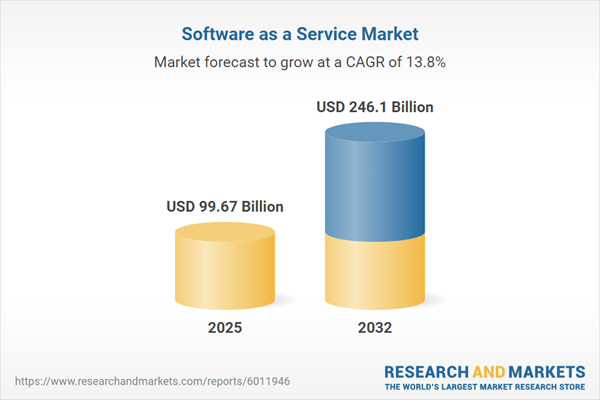Speak directly to the analyst to clarify any post sales queries you may have.
The software as a service (SaaS) market empowers organizations to scale operations, support digital transformation, and sustain business agility. Senior executives facing evolving competitive pressures turn to SaaS to optimize processes, enhance technology adoption, and maintain strategic flexibility.
SaaS Market Snapshot: Size, Dynamics, and Opportunity
The global SaaS market continues advancing rapidly, moving from USD 87.56 billion in 2024 to USD 99.67 billion in 2025, and is projected to reach USD 246.10 billion by 2032. This growth reflects a robust compound annual growth rate (CAGR) of 13.78%. Accelerators include fast-paced enterprise digital transformation, the adoption of artificial intelligence within business operations, and the broad integration of cloud-native architectures. Organizations in financial services, healthcare, manufacturing, IT, telecom, and retail are using SaaS solutions to increase automation and flexibility across varied business functions. Major SaaS vendors enable modular platform deployment, offering configurable solutions that address both core business needs and industry-specific challenges, securing SaaS as an essential component of enterprise-level digital strategies worldwide.
SaaS Market Scope & Segmentation
- Deployment Model: Private, public, hybrid cloud, and on-premises SaaS platforms each allow enterprises to align infrastructure decisions with compliance, data security, and governance requirements.
- Organization Size: Solutions are designed to serve large corporations, midsize firms, and small businesses, ensuring scalability and adaptation to unique workflow complexities and transformation demands.
- Industry Vertical: Financial services, healthcare, manufacturing, IT and telecom, retail, and e-commerce sectors each rely on SaaS to support specific needs like automation, data management, and regulatory compliance.
- Application Type: SaaS applications cover collaboration tools, CRM, ERP, HRM, and project management, streamlining interdepartmental workflows, reporting, and accountability for more efficient business operations.
- Pricing Model: Flexible approaches—including freemium, pay-as-you-go, subscription, and usage-based models—support precise budget control across diverse operational requirements.
- Regions Covered: Geographic deployment spans the Americas, Europe, Middle East, Africa, and Asia-Pacific, with countries such as the United States, Canada, China, India, and Japan leading adoption with mature regulatory frameworks and digital infrastructure.
- Key Companies: Providers like Microsoft, Salesforce, Adobe, Oracle, SAP, Intuit, ServiceNow, Shopify, Workday, and Zoom offer sector-specific innovation and integration capabilities that enhance compliance and manageability across the enterprise ecosystem.
SaaS Market Key Takeaways
- SaaS platforms facilitate integration and frequent system upgrades, delivering stable foundations for cloud-driven and hybrid IT strategies at every organizational scale.
- Advanced analytics and artificial intelligence features embedded in SaaS applications empower decision-makers with actionable, real-time business intelligence and performance monitoring.
- Comprehensive data privacy and security protocols in SaaS platforms reduce sector-specific compliance risk, especially in highly regulated industries such as finance and healthcare.
- Flexible payment arrangements give businesses the ability to control and realign technology budgets efficiently as operational priorities evolve.
- Strong partnerships and extensive ecosystem integrations ensure SaaS technologies remain adaptable, allowing organizations to respond quickly to changing market conditions and maintain ongoing value.
Tariff Impact: Navigating Regulatory Shifts
Ongoing shifts in U.S. tariff policy have led SaaS providers to expand infrastructure and diversify supply chains. These adjustments minimize hardware costs and reinforce compliance for businesses in regulated industries. By improving regulatory alignment, SaaS vendors help enterprises maintain continuous data operations and support effective risk management strategies, especially where oversight is stringent.
Methodology & Data Sources
This report synthesizes insights from direct interviews with C-level leaders, feedback from domain experts, and first-hand viewpoints across the SaaS value chain. Supplementary quantitative surveys and regulatory research further inform the analysis, providing credible, actionable market intelligence to support enterprise decision-makers.
Why This Report Matters
- Equips leadership with strategic direction to select the most suitable deployment models for complex operations across varied industries.
- Enhances vendor evaluation efforts by assessing providers’ competencies in security, innovation, and procurement—crucial for long-term organizational performance.
- Offers practical guidance to accelerate digital transformation and maximize operational efficiency using scalable SaaS solutions.
Conclusion
SaaS equips organizations with the adaptability needed to manage operational efficiency, regulatory obligations, and next-generation digital opportunities. The findings in this report assist senior leaders in refining technology strategies and fortifying business resilience in a dynamic enterprise landscape.
Additional Product Information:
- Purchase of this report includes 1 year online access with quarterly updates.
- This report can be updated on request. Please contact our Customer Experience team using the Ask a Question widget on our website.
Table of Contents
3. Executive Summary
4. Market Overview
7. Cumulative Impact of Artificial Intelligence 2025
Companies Mentioned
The companies profiled in this Software as a Service market report include:- Microsoft Corporation
- Salesforce, Inc.
- Adobe Inc.
- Oracle Corporation
- SAP SE
- Intuit Inc.
- ServiceNow, Inc.
- Shopify Inc.
- Workday, Inc.
- Zoom Video Communications, Inc.
Table Information
| Report Attribute | Details |
|---|---|
| No. of Pages | 185 |
| Published | October 2025 |
| Forecast Period | 2025 - 2032 |
| Estimated Market Value ( USD | $ 99.67 Billion |
| Forecasted Market Value ( USD | $ 246.1 Billion |
| Compound Annual Growth Rate | 13.7% |
| Regions Covered | Global |
| No. of Companies Mentioned | 11 |









